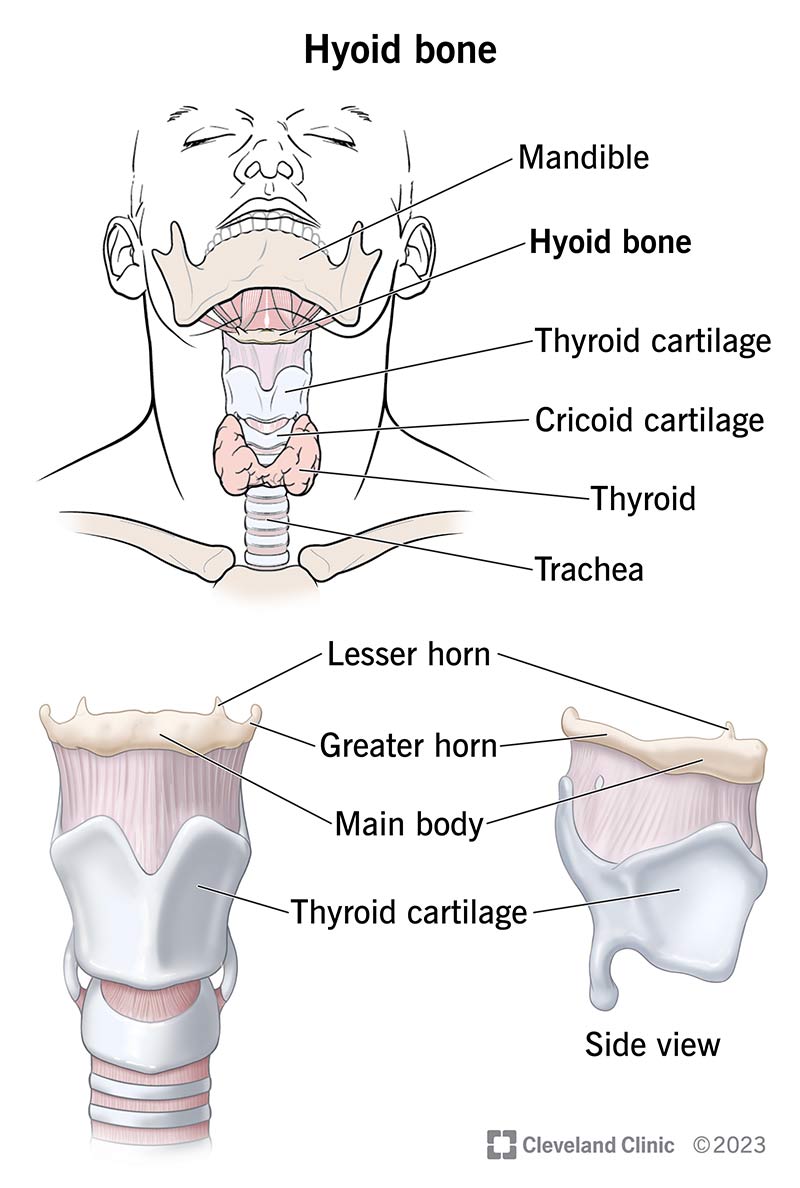Your hyoid bone is in the front of your neck. It supports your tongue and plays a key role in speaking and swallowing. Connected to nearby structures via ligaments, muscles and cartilage, your hyoid bone is the only “floating” bone in your body.

Your hyoid bone is a crescent-shaped bone at the front of your neck. It sits below your lower jaw (mandible) and above your thyroid cartilage (the protective tissue that covers your vocal cords). If you place your fingers where your chin and neck meet and then swallow, you can feel your hyoid bone.
The hyoid bone is special because it’s the only “floating” bone in your body. That means it’s not connected to any other bone. Rather, it’s held in place by ligaments, muscles and cartilage.
Advertisement
Cleveland Clinic is a non-profit academic medical center. Advertising on our site helps support our mission. We do not endorse non-Cleveland Clinic products or services. Policy
Your hyoid bone plays a key role in speaking, swallowing and breathing. It also provides support for several structures around it, like your:
Your hyoid bone is also an attachment point for three main ligaments and several muscles in your neck.
Your hyoid bone sits at the front of your neck, below your lower jaw and above your thyroid cartilage. If you picture your spine, your hyoid bone “floats” in front of your 4th cervical (neck) vertebrae.
Advertisement
Your hyoid bone is U-shaped and consists of three parts:
At birth, a newborn’s hyoid bone consists of three separate bones. During adulthood (usually between the ages of 40 and 60), those bones can fuse into one solid crescent-shaped structure. But for some people, this fusion never takes place. Having an unfused hyoid bone doesn’t mean there’s something wrong, though. It’s just a variation of normal.
There are a few health conditions that can affect your hyoid bone, including:
Conditions of the hyoid bone may share similar symptoms. Some of the most common include:
Symptoms of some hyoid bone conditions are similar to those of temporomandibular joint (TMJ) disorders. Because of this, some people get misdiagnosed. If you’ve received treatment for TMJ conditions but you haven’t noticed any improvement, ask your healthcare provider if your hyoid bone might be the culprit.
Healthcare providers may use several imaging tests to check the health of your hyoid bone, like:
It depends on which condition you have. But some of the most common treatments include:
Advertisement
Hyoid bone conditions are rare, and they usually happen due to factors that are out of your control. But if you’re having persistent neck or throat pain, difficulty swallowing or other symptoms mentioned here, talk to your healthcare provider. Early detection and treatment are key.
No, your Adam’s apple (also called your laryngeal prominence) is part of your thyroid cartilage. Your hyoid bone sits above your thyroid cartilage. Though these structures are near one another, they’re different parts of your anatomy that serve different functions.
A note from Cleveland Clinic
Your hyoid bone is small, tucked away under your lower jaw, surrounded by protective layers of muscles, ligaments and cartilage. It’s so hidden you probably don’t think about it much — unless it starts to hurt. Hyoid bone conditions are rare. But if you develop hoarseness, shortness of breath, difficulty swallowing or persistent and unexplained pain in your neck or throat, tell your healthcare provider. They can come up with a personalized treatment plan to ease your symptoms and get you back on track.
Last reviewed on 11/07/2023.
Learn more about the Health Library and our editorial process.
Advertisement
Cleveland Clinic is a non-profit academic medical center. Advertising on our site helps support our mission. We do not endorse non-Cleveland Clinic products or services. Policy